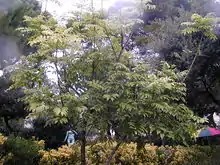Indolizidine alkaloids
Indolizidine alkaloids are natural products from various alkaloid groups whose structure can be derived from indolizidine.[1]



Occurrence
Indolizidine alkaloids are present in various plant families, including Elaeocarpaceae, Asclepiadaceae, and are also produced as metabolites by fungi and bacteria.[2] For instance, Slaframine and swainsonine were identified in the fungus Rhizoctonia leguminicola,[3] while Castanospermine was extracted from Castanospermum australe.[2] Notably, this alkaloid group includes pumiliotoxins, which are the toxins of the strawberry poison-dart frog.[2]
Representatives
Polyhydroxy alkaloids
The polyhydroxy alkaloids include compounds like castanospermine and swainsonine.[1]
-Castanospermine_Structural_Formula_V1.svg.png.webp) (+)-Castanospermine
(+)-Castanospermine-Swainsonine_Structural_Formula_V2.svg.png.webp) (-)-Swainsonine
(-)-Swainsonine
Pumiliotoxins
The primary alkaloids within the pumiliotoxin category are pumiliotoxin A and pumiliotoxin B.[2] Other representatives include gephyrotoxin 223 AB and gephyrotoxin.[3]
Phenanthroindolizidine alkaloids
Representatives of this alkaloid group include tylophorine, tylocrebrine and tylophorinidine.[4][5]
-Tylophorine_Structural_Formula_V2.svg.png.webp) (+)-Tylophorine
(+)-Tylophorine (+)-Tylocrebrine
(+)-Tylocrebrine
Elaeocarpus alkaloids
Representatives of this group include Elaeocanine A, Elaeocarpine and Elaeocarpidine.[6]
Securinega alkaloids
The main alkaloid in this category is securinine. Others are securinol A and norsecurinine.[7]
-Norsecurinine_Structural_Formula_V1.svg.png.webp) (-)-Norsecurinine
(-)-Norsecurinine
Tylophora alkaloids
Most of the Tylophora alkaloids belong to the phenanthroindolizidine alkaloid family, including tylophorine, septicin, and hispidine.[8]
Ipomoea alkaloids
Main alkaloids of this group are Ipalbin and Ipomin. Furthermore, Ipalbidine and Ipohardine occur.[9]
-Ipalbidine_Structural_Formula_V2.svg.png.webp) (+)-Ipalbidine
(+)-Ipalbidine
Properties
Swainsonine-type compounds are currently under investigation for their potential as active agents against AIDS. Swainsonine and castanospermine function as inhibitors of sugar-splitting enzymes. Castanospermine also exhibits anti-cancer and anti-HIV properties,[2] while Slaframine acts as a parasympathomimetic agent. Pumiliotoxin A enhances the contraction of striated muscle, and gephyrotoxin has similar effects to pumiliotoxin A. Due to their multifaceted impacts on the nervous system, these alkaloids are in high demand. However, their natural availability through frog skin extraction is severely limited due to species protection measures.[3]
References
- Entry on Indolizidin-Alkaloide. at: Römpp Online. Georg Thieme Verlag, retrieved {{{Datum}}}.
- H. Latscha, U. Kazmaier (2016), Chemie für Biologen (4 ed.), Berlin Heidelberg: Springer Spektrum, pp. 685f, ISBN 9783662477830
- G. Habermehl, P. Hammann, H. Krebs (2002), Naturstoffchemie (2 ed.), Berlin Heidelberg: Springer-Verlag, pp. 201ff, ISBN 9783540439523
{{citation}}: CS1 maint: multiple names: authors list (link) - Eberhard Breitmaier (1997), Alkaloide, Wiesbaden: Springer Fachmedien, pp. 44f, ISBN 9783519035428
- Entry on Phenanthroindolizidin-Alkaloide. at: Römpp Online. Georg Thieme Verlag, retrieved {{{Datum}}}.
- Entry on Elaeocarpus-Alkaloide. at: Römpp Online. Georg Thieme Verlag, retrieved {{{Datum}}}.
- Entry on Indolizidine alkaloids. at: Römpp Online. Georg Thieme Verlag, retrieved {{{Datum}}}.
- Entry on Tylophora-Alkaloide. at: Römpp Online. Georg Thieme Verlag, retrieved {{{Datum}}}.
- Entry on Ipomoea-Alkaloide. at: Römpp Online. Georg Thieme Verlag, retrieved {{{Datum}}}.